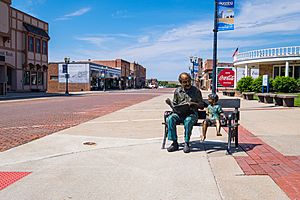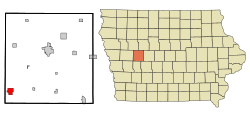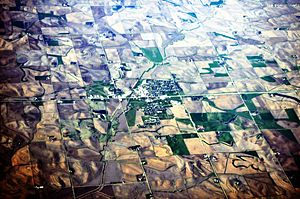Manning, Iowa facts for kids
Quick facts for kids
Manning, Iowa
|
|
|---|---|
 |
|

Location of Manning, Iowa
|
|
| Country | |
| State | |
| County | Carroll |
| Area | |
| • Total | 2.48 sq mi (6.43 km2) |
| • Land | 2.48 sq mi (6.41 km2) |
| • Water | 0.01 sq mi (0.02 km2) |
| Elevation | 1,368 ft (417 m) |
| Population
(2020)
|
|
| • Total | 1,455 |
| • Density | 587.64/sq mi (226.85/km2) |
| Time zone | UTC-6 (Central (CST)) |
| • Summer (DST) | UTC-5 (CDT) |
| ZIP code |
51455
|
| Area code(s) | 712 |
| FIPS code | 19-48945 |
| GNIS feature ID | 468338 |
Manning is a small city in Carroll County, Iowa, United States. It is located along Iowa Highway 141. In 2020, about 1,455 people lived there. The city is named after Orlando Harrison Manning, who was once a Lieutenant Governor of Iowa.
Contents
History of Manning
Before Manning became a city, the area was mostly a swampy place. Local Iowa Native Americans sometimes used it for hunting. There were not many rivers or trees nearby.
In 1880, the Iowa Southwestern railroad was finished. Train yards and a station were built in 1881 where Manning is now. In the same year, another railroad, the Chicago, Milwaukee, and St. Paul Railroad, built tracks across Iowa. These two railroads met at the spot that would become Manning.
In 1969, an unknown person caused a train to derail on the Milwaukee railroad line. The train stopped safely, and no one was hurt. The reason for this event was never found out.
Geography of Manning
Manning is located near the start of the West Nishnabotna River.
The city covers a total area of about 2.50 square miles (6.43 square kilometers). Most of this area is land, with only a small part being water.
People of Manning
Manning is home to a friendly community. Here's how the number of people living in Manning has changed over the years:
| Historical populations | ||
|---|---|---|
| Year | Pop. | ±% |
| 1890 | 1,233 | — |
| 1900 | 1,169 | −5.2% |
| 1910 | 1,434 | +22.7% |
| 1920 | 1,863 | +29.9% |
| 1930 | 1,817 | −2.5% |
| 1940 | 1,748 | −3.8% |
| 1950 | 1,801 | +3.0% |
| 1960 | 1,676 | −6.9% |
| 1970 | 1,656 | −1.2% |
| 1980 | 1,609 | −2.8% |
| 1990 | 1,484 | −7.8% |
| 2000 | 1,490 | +0.4% |
| 2010 | 1,500 | +0.7% |
| 2020 | 1,455 | −3.0% |
| Source: and Iowa Data Center Source: |
||
Population in 2020
In 2020, there were 1,455 people living in Manning. The average age of people in the city was about 41.5 years old. About 25% of the residents were under 20 years old, and about 25% were 65 years or older.
Famous People from Manning
Manning has been the home of several notable people:
- Matt Campbell (born 1970): A lawyer who ran for the United States House of Representatives.
- James Drees (1930–2022): A farmer and a politician in the Iowa state government.
- John R. Hansen (1901–1974): He was a U.S. Representative for Iowa. He was born and lived in Manning his whole life.
- Tom Knudson (born 1953): An American journalist who won the Pulitzer Prize two times. He was born in Manning.
Education in Manning
The IKM–Manning Community School District runs the public schools in Manning. Before 2011, Manning had its own school district, but it joined with IKM to form the current district.
Other schools nearby include:
- Kuemper Catholic School System in Carroll.
- Community colleges like Des Moines Area Community College (DMACC) Carroll Campus, Western Iowa Tech Community College (WITCC) Denison Campus, and Iowa Western Community College (IWCC) in nearby counties.
Manning's Sporting Achievements
Manning has a proud history in sports:
- In 1948, the Manning boys' basketball team won the state championship in Iowa! It was a big surprise because Manning was a small town, and they beat a much larger team from Davenport with a score of 46–43.
- In 2002, the Manning High School football team also won the State of Iowa Class A championship. They had an amazing season, winning 12 games and only losing one. They won the final game against Fredericksburg with a score of 52–0.
See also
 In Spanish: Manning (Iowa) para niños
In Spanish: Manning (Iowa) para niños


